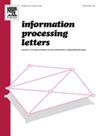The harmonious coloring game
IF 0.6
4区 计算机科学
Q4 COMPUTER SCIENCE, INFORMATION SYSTEMS
引用次数: 0
Abstract
A harmonious k-coloring of a graph G is a 2-distance proper k-coloring of its vertices such that each edge is uniquely identified by the colors of its endpoints. Here, we introduce its game version: the harmonious coloring game. In this two-player game, Alice and Bob alternately select an uncolored vertex and assigns to it a color in with the constraint that, at every turn, the set of colored vertices induces a valid partial harmonious coloring. Alice wins if all vertices are colored; otherwise, Bob wins. The harmonious game chromatic number is the minimum integer k such that Alice has a winning strategy with k colors. In this paper, we prove the PSPACE-hardness of three variants of this game. As a by-product, we prove that a variant introduced by Chen et al. in 1997 of the classical graph coloring game is PSPACE-hard even in graphs with diameter two. We also obtain lower and upper bounds for in graph classes, such as paths, cycles, grids and forests of stars.
和谐的填色游戏
图G的和谐k-着色是其顶点的2距离固有k-着色,使得每条边都由其端点的颜色唯一标识。在这里,我们介绍一下它的游戏版本:和谐着色游戏。在这个双人游戏中,Alice和Bob轮流选择一个未上色的顶点,并在{1,…,k}中为其分配一个颜色,同时约束是,在每一轮中,上色顶点集合都会产生一个有效的部分和谐上色。如果所有顶点都有颜色,则Alice获胜;否则,鲍勃赢。和谐博弈色数χhg(G)是最小整数k,使得Alice拥有k种颜色的获胜策略。本文证明了该对策的三种变体的pspace -硬度。作为副产品,我们证明了Chen等人在1997年引入的经典图着色游戏的一个变体即使在直径为2的图中也是PSPACE-hard的。我们还得到了图类中χhg(G)的下界和上界,如路径、循环、网格和星形森林。
本文章由计算机程序翻译,如有差异,请以英文原文为准。
求助全文
约1分钟内获得全文
求助全文
来源期刊

Information Processing Letters
工程技术-计算机:信息系统
CiteScore
1.80
自引率
0.00%
发文量
70
审稿时长
7.3 months
期刊介绍:
Information Processing Letters invites submission of original research articles that focus on fundamental aspects of information processing and computing. This naturally includes work in the broadly understood field of theoretical computer science; although papers in all areas of scientific inquiry will be given consideration, provided that they describe research contributions credibly motivated by applications to computing and involve rigorous methodology. High quality experimental papers that address topics of sufficiently broad interest may also be considered.
Since its inception in 1971, Information Processing Letters has served as a forum for timely dissemination of short, concise and focused research contributions. Continuing with this tradition, and to expedite the reviewing process, manuscripts are generally limited in length to nine pages when they appear in print.
 求助内容:
求助内容: 应助结果提醒方式:
应助结果提醒方式:


